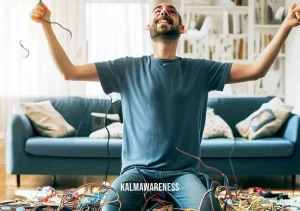Can I Lay Down to Meditate: Understanding the Benefits and Pitfalls of Prone Meditation
Meditation has increasingly become an essential part of self-care routines worldwide. The practice has been lauded for its incredible benefits, including stress reduction, increased awareness, and fostering a peaceful state of mind. But one common question that often crops up, especially among newcomers, is: can I lay down to meditate? It’s an intriguing query that deserves comprehensive analysis, especially considering the variety of positions people adopt for meditation, such as seated, standing, or even walking.
A Closer Look at Conventional Meditation Postures
Traditionally, the lotus position or sitting cross-legged on the floor has been the staple posture for meditation. Proponents argue that this upright stance keeps the spine straight, enabling a more alert state of mind. This is crucial for practices like Mindful Hypnobirthing or Rouse Yoga, where concentration and a stable flow of energy are paramount.
However, the world of meditation is expanding, and so are its techniques. There are meditation exercises that involve movement, some that incorporate sound at 256 Hz for unique benefits, and others specifically tailored for teenagers involving walking meditation.
The Lure of Lying Down: Prone Meditation
The idea of lying down to meditate stems from our natural desire for comfort and relaxation. This position taps into a familiar state of rest, making it potentially easier for many to begin the practice. Indeed, if you’re starting with guided meditations like Jack Kornfield’s Meditation for Beginners, lying down could be a suitable introduction.
Reclining during meditation can also be an excellent option for those dealing with physical challenges. In these cases, it’s essential to know how to stabilize the body and mind effectively while lying down.
However, there’s a significant concern with prone meditation: the risk of falling asleep. This isn’t necessarily a problem if you’re looking for practices like Mindful Movement for Sleep or a 15-minute power nap. Still, it can become a hindrance if the aim involves attaining a peaceful state of mind in which thoughts are not occupied by worry.
Key Considerations for Lying Down to Meditate
- Choose Your Setting Wisely: The surroundings play a crucial role. A place free from distractions and conducive to sustainable self-care is ideal.
- Body Awareness: Focusing on different parts of your body, as you would in EMDR meditation or exercises that encourage you to touch that body part mindfully, can prevent you from dozing off.
- Breathing Techniques: Incorporating specific breathing methods can help maintain an alert mind. These methods help you understand how we get deep into meditation so fast.
In meditation, the position of your body should facilitate the position of your mind. It should aid, not hinder, the mental work at hand. — Judgement of the Wise
To sum up, can you meditate lying down? Absolutely. It’s not a one-size-fits-all practice. However, the position you choose should align with your objectives, physical abilities, and the specific type of meditation you’re practicing. Whether you opt for lying down, sitting, or standing, what’s most important is to keep in mind the definition of your goals and how best to achieve them.
Curious about making meditation even simpler and more effective? Continue reading as we delve into tailored meditation practices that suit different lifestyles, body types, and objectives in the next segment.

Exploring the Nuances: Laying Down to Meditate vs. Traditional Approaches
As we already established, lying down to meditate is a viable option. It can bring unique benefits and may be especially suitable for those with specific physical limitations. However, lying down for meditation isn’t a blanket solution for everyone. Let’s expand on this concept, presenting you with a more detailed view that incorporates diverse practices and considerations, enhancing the essential inquiry: Can I lay down to meditate?
A Diverse Palette of Techniques and Positions
Meditation is far from monolithic. It embraces an array of techniques, each with its distinctive focus, benefits, and appropriate postures. Take, for example, the case of EMDR Meditation, which concentrates on Eye Movement Desensitization and Reprocessing. On the other hand, the judgment of the wise approach emphasizes the role of discernment in mindfulness.
Lying Down to Meditate: A Synopsis
- Flexibility: You can integrate various techniques, such as body scans, even when you lie down.
- Convenience: No need for special cushions or seating arrangements.
- Ease of Breathing: The prone position can facilitate easier breathing, especially for beginners.
Why Laying Down to Meditate Can Be Beneficial
A Table to Weigh Your Options
| Position | Advantages | Disadvantages | Ideal For |
|---|---|---|---|
| Lying Down | Comfort, easier breathing | Risk of sleep | Beginners, those with physical limitations |
| Seated | Greater alertness, traditional method | Potential discomfort | Long meditation sessions |
| Standing | Maximum alertness, better energy flow | Fatigue, risk of distraction | Shorter mindfulness practices |
| Walking | Physical activity, awareness | Requires more space, less relaxed | Active mindfulness |
The table above provides a snapshot, helping you compare the efficacy of different meditation postures, thereby stressing the importance of the main query: Can I lay down to meditate?
Beyond Relaxation: The Elemental Role of Breathing
One aspect that deserves special mention is the breathing techniques. As we covered earlier, the prone position can be conducive to more straightforward breathing exercises. If you’re exploring breathing techniques such as one for each blessed day, lying down might be an excellent place to start. For those who have mastered breathing techniques, they may find that lying down allows them to delve deeper into how we get deep so fast.
Caveats and Precautions
While lying down has its merits, it’s crucial to keep in mind the definition of what you aim to achieve with your meditation. If your goal involves attaining a peaceful state of mind in which thoughts are not occupied by worry, lying down may work for you. On the other hand, if you’re looking to sharpen your focus and alertness, a seated or standing position might be more beneficial.
In summary, the decision to lay down while meditating should be based on multiple factors, from the technique being employed to your unique physical needs and mental goals. After all, the primary aim of meditation is not merely about relaxation but achieving a harmonious state of body and mind.
So, is lying down to meditate a legitimate and effective way to practice? Absolutely, but like any other tool, it has to be used appropriately, taking into account your objectives, conditions, and the type of meditation you’re practicing.
Intrigued to discover how you can further optimize your meditation sessions with tailored methods? Continue reading as we introduce some exciting practices that focus not just on the mind but also on your overall well-being in the next segment.

Meditating Horizontally: A Pathway to Hope and Inspiration
The notion that you can lay down to meditate is not just a concession to comfort but often a door to a world of inspiration and hope. It is about listening to your body and recognizing that meditation is not a one-size-fits-all journey. In this segment, let’s explore how this liberating position for meditation can provide room for growth, reflection, and most importantly, hope.
Unraveling the Inspirational Potential of Lying Down Meditation
“The quieter you become, the more you can hear,” said spiritual teacher Ram Dass. In a world where we’re often taught to be in perpetual motion, lying down in meditation offers a counter-narrative. It grants us the license to stop, listen, and be inspired.
Notably, lying down can be the perfect position to engage in Mindful Hypnobirthing, a practice that draws on the soothing power of the mind to ease the physical strain of labor. But its applications don’t stop there; it can serve as a means to cultivate hope in daily life.
A Journey of the Mind While Reclining
“The best way to capture moments is to pay attention,” remarked Jon Kabat-Zinn, an advocate for mindfulness meditation. And sometimes, paying attention is more comfortable and more authentic when we are reclined. When we lay down to meditate, the simple act of relaxation can open us up to pretty soon meaning, discovering the essence of life’s transient moments. For those who struggle to find a peaceful moment amidst the chaos, a 15-minute power nap combined with meditation can serve as a mini-retreat for the mind.
Integrating Sustainable Self-Care and Mindfulness
“[S]elf-care is never a selfish act—it is simply good stewardship of the only gift I have, the gift I was put on earth to offer to others,” says Parker J. Palmer. Sustainable self-care means making choices that are right for you, regardless of how unconventional they may seem to others. Lying down to meditate certainly falls under sustainable self-care, as it provides an alternate yet effective route to self-discovery and healing. If you’re a parent grappling with the daily demands of childcare, or a teenager navigating the labyrinth of adolescence, the option to meditate while lying down can be a small yet impactful act of self-care. Indeed, it might make teenagers walking the path of life find the process of mindfulness more accessible.
Inviting Peace through Elemental Sounds
While lying down, you can also enhance your meditative experience through the addition of auditory elements. For example, tuning into frequencies such as 256 Hz can complement the meditative state. “Music in the soul can be heard by the universe,” Lao Tzu once mentioned. By combining the prone position with these frequencies, you might find a unique pathway to inner peace.
Meditating Lying Down: A Sanctuary for the Spirit
“Your work is to discover your world and then with all your heart give yourself to it,” a quote attributed to Buddha. The same applies to meditation. The whole idea behind “Can I lay down to meditate?” is to find what resonates with you, what allows your spirit to soar, and what imbues your journey with hope and inspiration.
As we’ve explored, lying down during meditation is more than a concession to comfort—it’s an invitation to experience mindfulness on your own terms. While there are many paths to tranquility and enlightenment, the crucial part is that you find the one that helps you become your best self.
Feel invigorated? Ready to take actionable steps to elevate your meditative journey? In the next segment, we’ll dive into the practicalities and tips to turn your lying-down meditation into a transformative experience. Continue reading to unlock your pathway to serenity and inspiration.

The Practicalities of Lying Down to Meditate: A Detailed Guide
In our journey to explore the expansive question of “Can I lay down to meditate?”, we’ve discussed its emotional, inspirational, and self-care facets. Now, let’s delve into the nitty-gritty and examine the practical aspects of meditating while lying down. With meticulous detail, this segment will break down the elements that make this form of meditation both unique and transformative.
Key Benefits of Lying Down to Meditate
A significant portion of the meditation community argues that lying down for mindfulness activities can offer a plethora of benefits. Here are a few:
- Enhanced Relaxation: Lying down naturally relaxes the muscles, preparing the body and mind for a deeper state of relaxation. This prepares you to involve attaining a peaceful state of mind in which thoughts are not consumed by worry.
- Accessibility: For those with mobility issues or chronic pain, lying down provides a more accessible option.
- Breathing Advantages: Lying down can facilitate diaphragmatic breathing, aligning with techniques such as Rouse Yoga that also emphasize the breath.
- Facilitates Body Awareness: Practicing mindful movement or scanning the body is easier when lying down. This is particularly useful for touching that body part mindfully and fostering awareness.
- Ideal for EMDR Meditation: Eye Movement Desensitization and Reprocessing (EMDR) meditation is often more comfortable in a reclining position, as expounded in EMDR meditation techniques.
Guiding Principles for Effective Lying Down Meditation
Meditating in a prone position isn’t just about laying down wherever you feel like. There are some principles to keep in mind for an effective session:
- Location: Choose a spot that is both comfortable and free from distractions.
- Posture: Keep your legs uncrossed and your arms at your sides, palms facing up.
- Duration: Opt for a length of time that is manageable for you, whether it’s a quick mindful movement sleep or an extended 30-minute session.
- Intention: Before starting, set an intention for your session. This aligns with the judgement of the wise, a philosophical concept encouraging purposeful action.
Tools and Resources to Augment Lying Down Meditation
Supplement your practice with tools and resources to enrich the experience:
- Guided Meditations: Websites and apps that offer meditation made simple can be particularly useful.
- Timers: Use a meditation timer to spell stabilize your practice, creating a regular and stable routine.
- Journal: Maintain a journal to keep track of your thoughts, feelings, and observations. This allows you to reflect on one for each blessed day you engage in meditation.
Tailoring Meditation to Your Unique Needs
Ultimately, the decision to meditate while lying down should be based on personal preferences and individual circumstances. Whether you’re a beginner seeking guidance from Jack Kornfield’s Meditation for Beginners or an advanced practitioner exploring the element of some meditation exercises, the most important thing is to listen to yourself.
Excited to dive even deeper? Stay with us for the final chapter where we pull together the wisdom and practical tips surrounding the compelling topic of lying down to meditate. This next segment promises to be an enlightening summary that will equip you with everything you need to confidently practice meditation in the prone position. So, continue reading to complete your understanding of this rewarding practice.

The Reclining Road to Mindfulness: A Farewell to Our Journey on “Can I Lay Down to Meditate?”
As we draw the curtains on our expedition through the dimensions of reclining meditation, it’s fitting to revisit our key takeaways and gaze into the future of this enriching practice. The question “Can I lay down to meditate?” started us on this journey. Now, as we prepare to bid adieu, we realize that this was more than a question—it was a portal to a deeper, more personalized understanding of mindfulness and self-care.
Why Lying Down to Meditate Deserves Your Attention
It’s worth reiterating that laying down to meditate isn’t a lazy compromise—it’s an empowering choice. Whether it’s an efficient 15-minute power nap meditation, or integrating the practice into sustainable self-care, there is no one-size-fits-all in mindfulness. Remember, the best posture for you is the one that allows you to remain focused and free from physical discomfort, allowing you to get deep into meditation so fast.
The Power of Adaptive Meditation
Being flexible in our meditation practice makes it more accessible, allowing us to integrate it into our daily lives with ease. In a hectic world where teenagers are walking on the tightrope of social pressures and schoolwork, or where the elders are facing mobility challenges, prone meditation can serve as a universal solace.
Frequencies and Fine-tuning: The Future of Reclining Meditation
As we look toward the future, innovations like frequency modulation can be used to amplify the benefits of lying down to meditate. The 256 Hz benefits, for example, explore the resonance of sound frequencies in deepening our meditative states.
A Light-Hearted Conclusion
We began as mere wanderers in the land of reclining mindfulness, skeptics asking, “Can I lay down to meditate?”. But here we are, graduates of this explorative curriculum, equipped to keep in mind the definition of adaptable and empowering mindfulness practices. Cheers to us!
What Next?
So, what do you do after turning the last page of this guide? You live it! You breathe it! Dive back into the content to fortify your understanding. Reread the chapters, practice the techniques, and watch as the world around you begins to shift. Yes, change starts within, and your newfound wisdom is the key.
A Gratitude-Infused Farewell
We would be remiss if we didn’t extend our sincerest gratitude for your presence in this journey. Your curiosity propelled us, and we’re excited to explore even more avenues in our next editions. If you ever find yourself questioning the wisdom of a mindful approach, remember the essence of the judgment of the wise—it’s all about intentionality, purpose, and self-respect.
So, whether you’re a beginner in the world of mindfulness or a seasoned practitioner, always remember to tune in to what feels right for you. We promise there will be a lot more to explore, uncover, and experience in our upcoming content. Until then, may you continue to find peace, comfort, and a whole lot of mindfulness, in whatever position you choose to meditate. Thank you for journeying with us. 🙏





